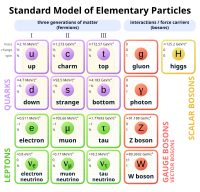
Photo from wikipedia
We analyze the theoretical and phenomenological considerations for the electroweak phase transition and dark matter in an extension of the standard model with a complex scalar singlet (cxSM). In contrast… Click to show full abstract
We analyze the theoretical and phenomenological considerations for the electroweak phase transition and dark matter in an extension of the standard model with a complex scalar singlet (cxSM). In contrast with earlier studies, we use a renormalization group improved scalar potential and treat its thermal history in a gauge-invariant manner. We find that the parameter space consistent with a strong first-order electroweak phase transition (SFOEWPT) and present dark matter phenomenological constraints is significantly restricted compared to results of a conventional, gauge-noninvariant analysis. In the simplest variant of the cxSM, recent LUX data and a SFOEWPT require a dark matter mass close to half the mass of the standard model-like Higgs boson. We also comment on various caveats regarding the perturbative treatment of the phase transition dynamics.
Journal Title: Physical Review D
Year Published: 2018
Link to full text (if available)
Share on Social Media: Sign Up to like & get
recommendations!